Charles E W Bean, Diaries, AWM38 3DRL 606/274A/1 - 1918 - 1941 - Part 1
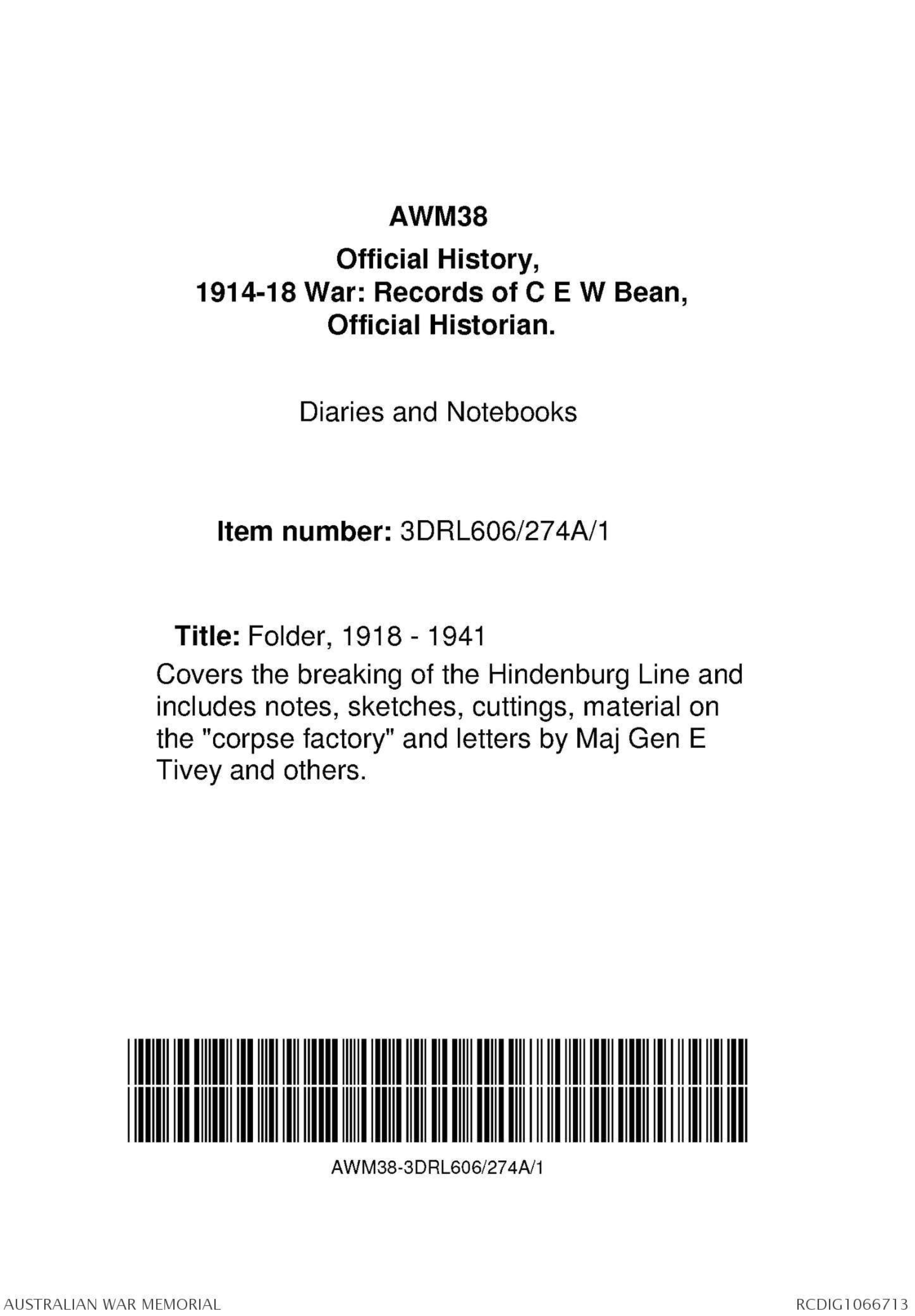
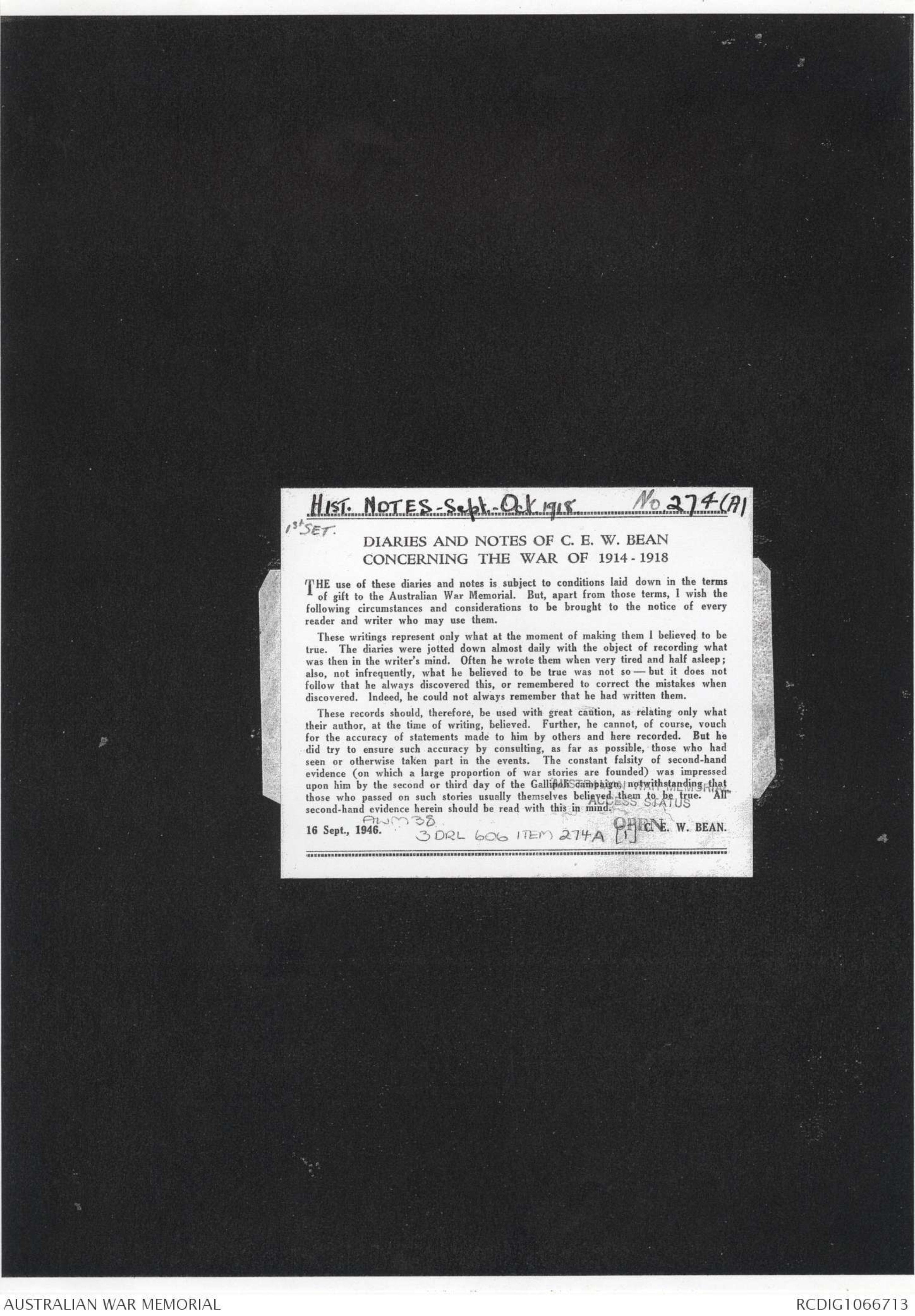
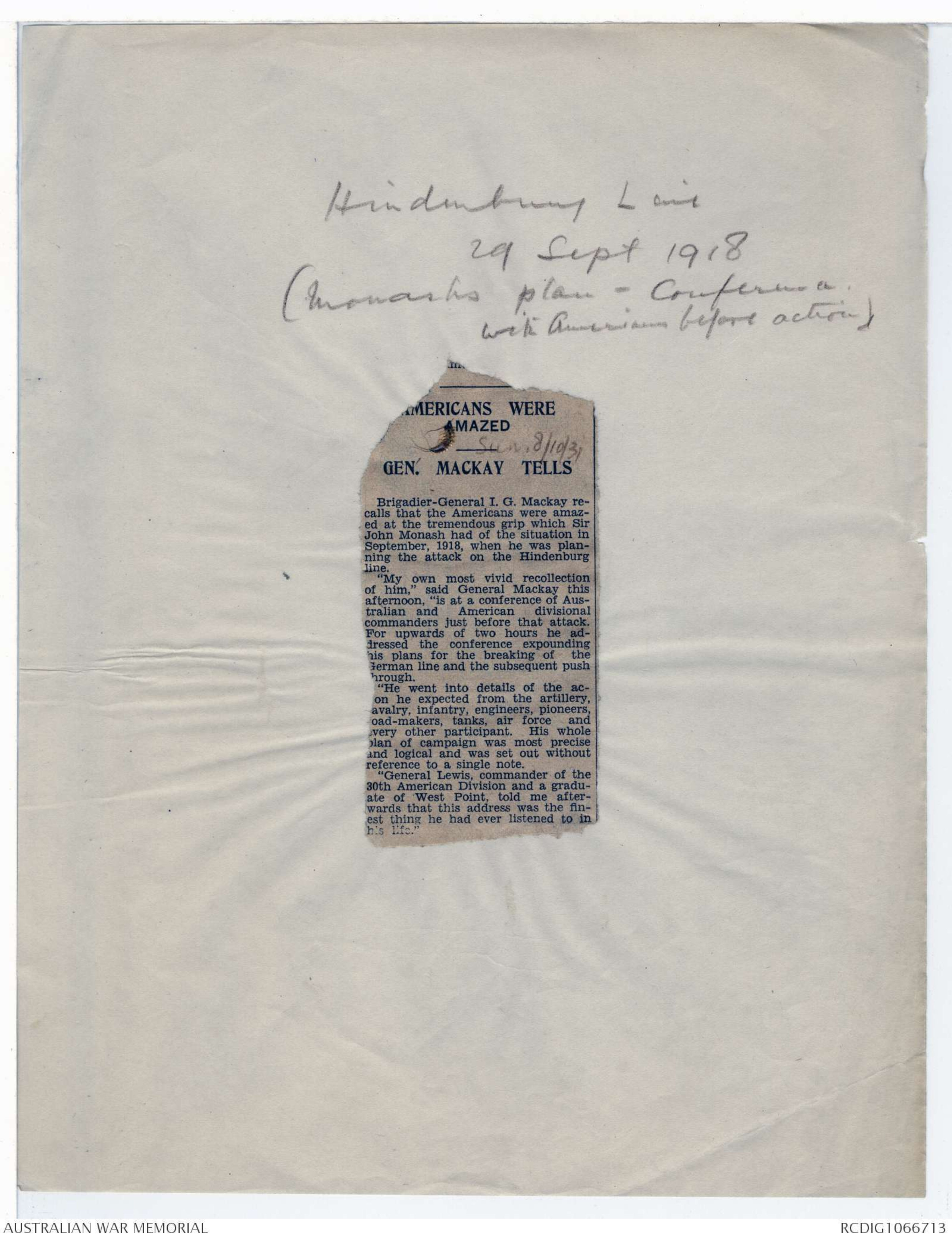
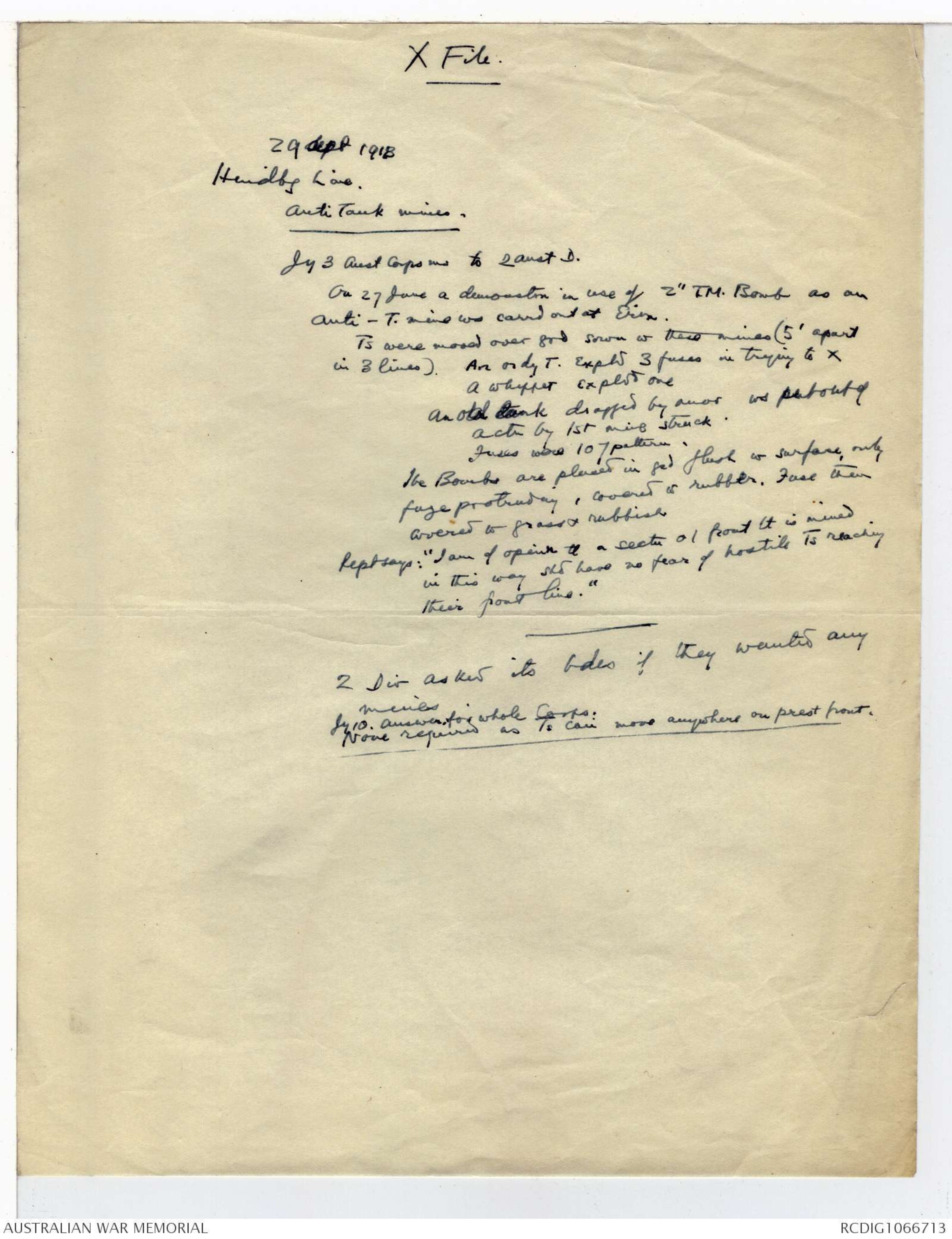
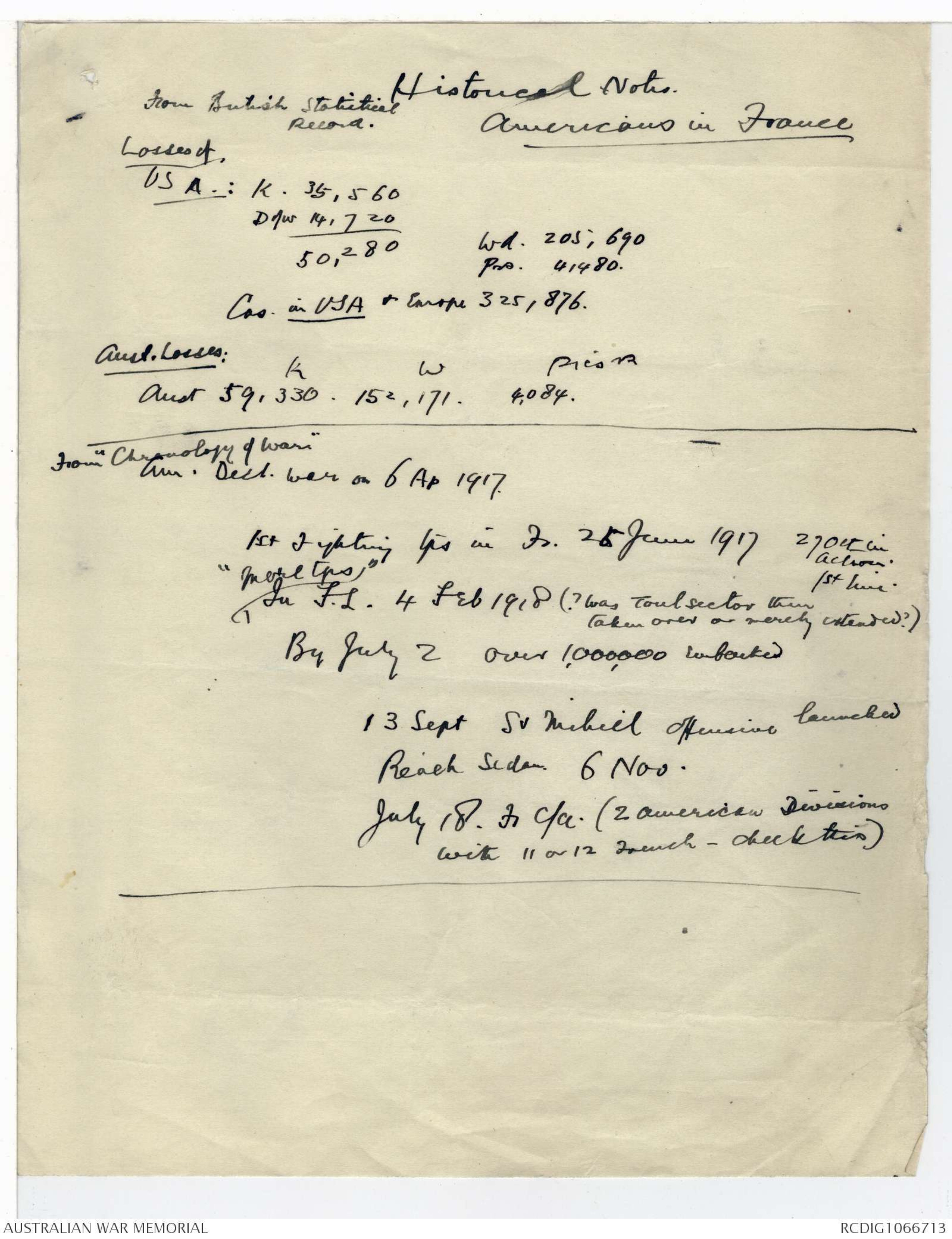
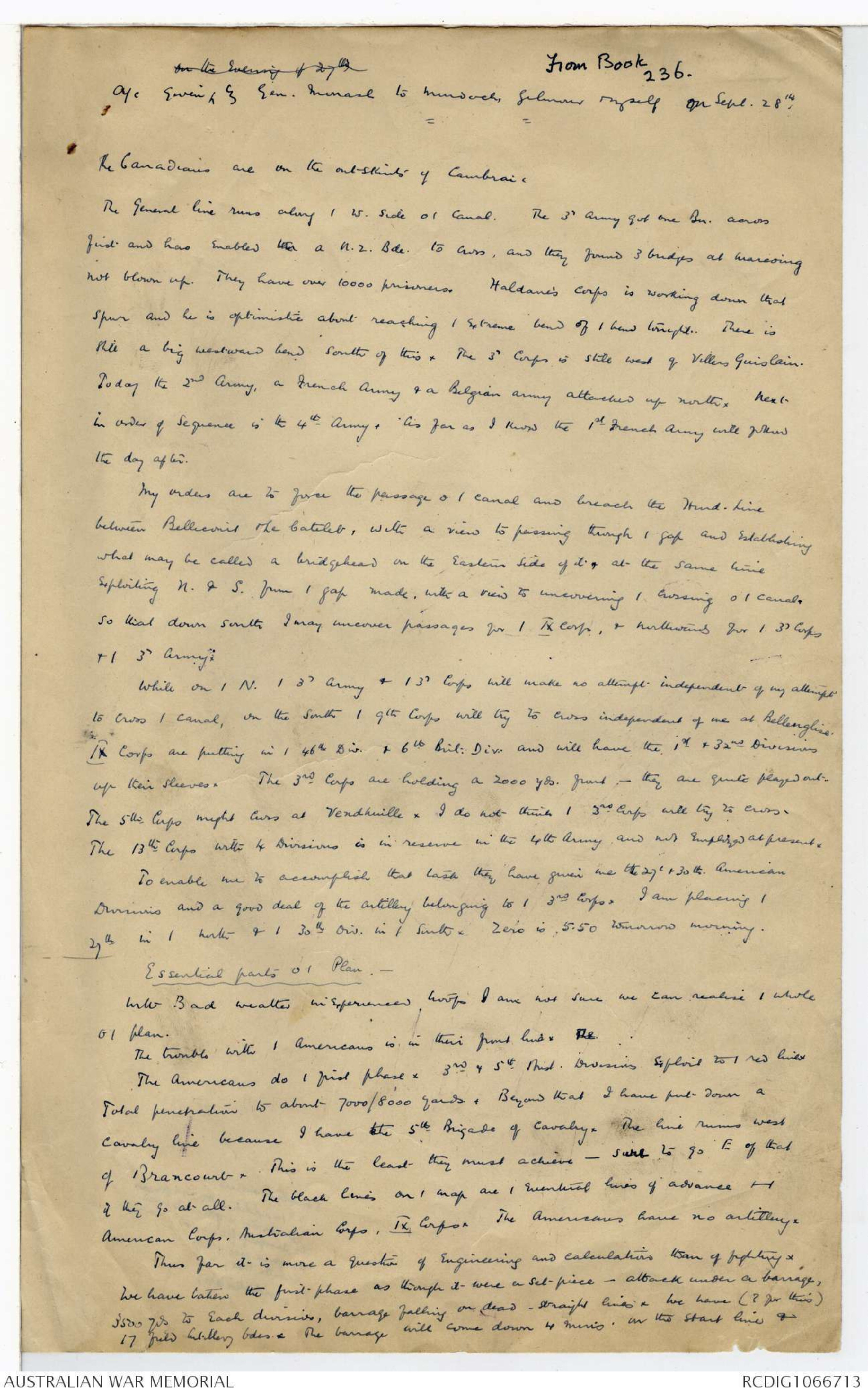
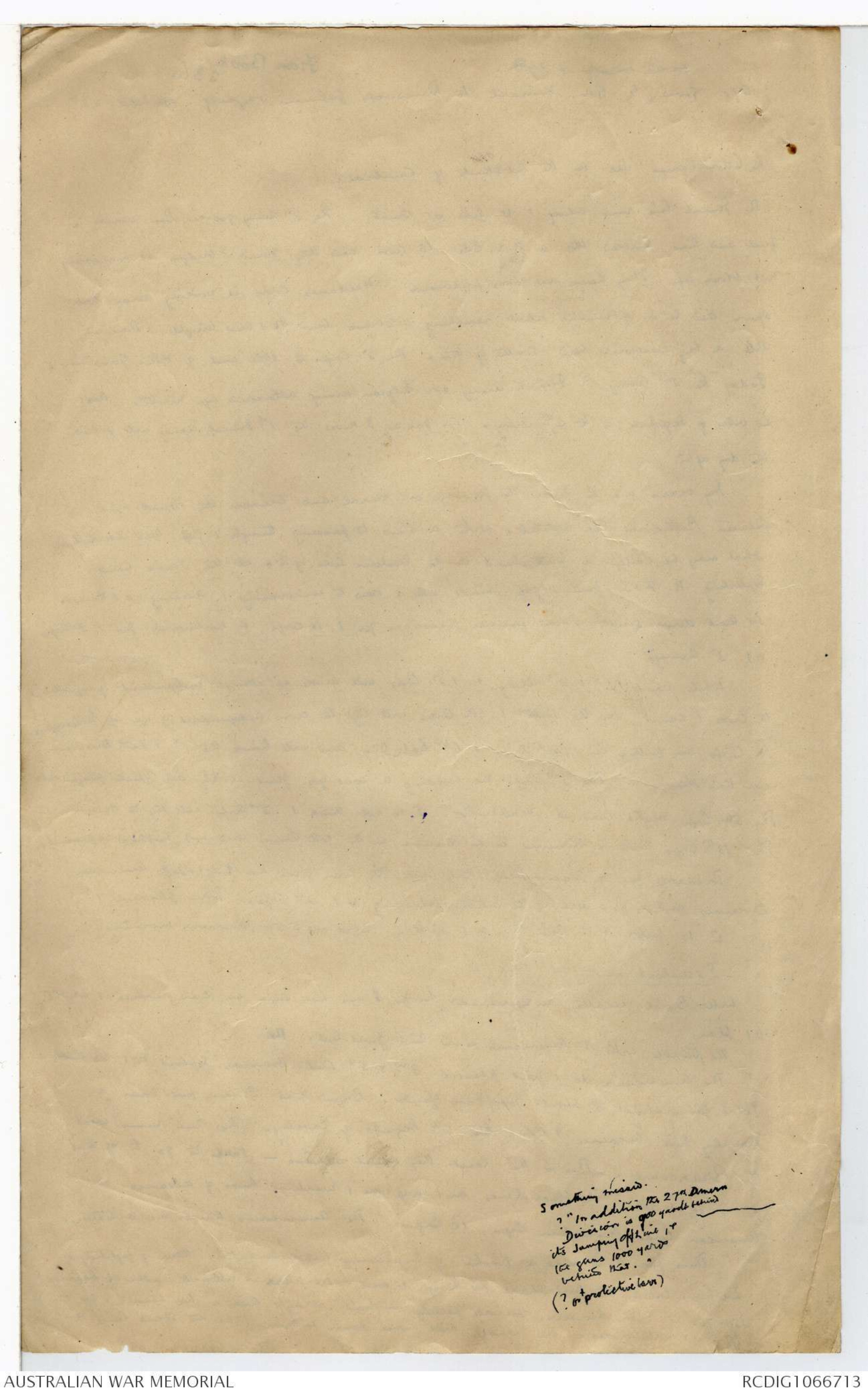
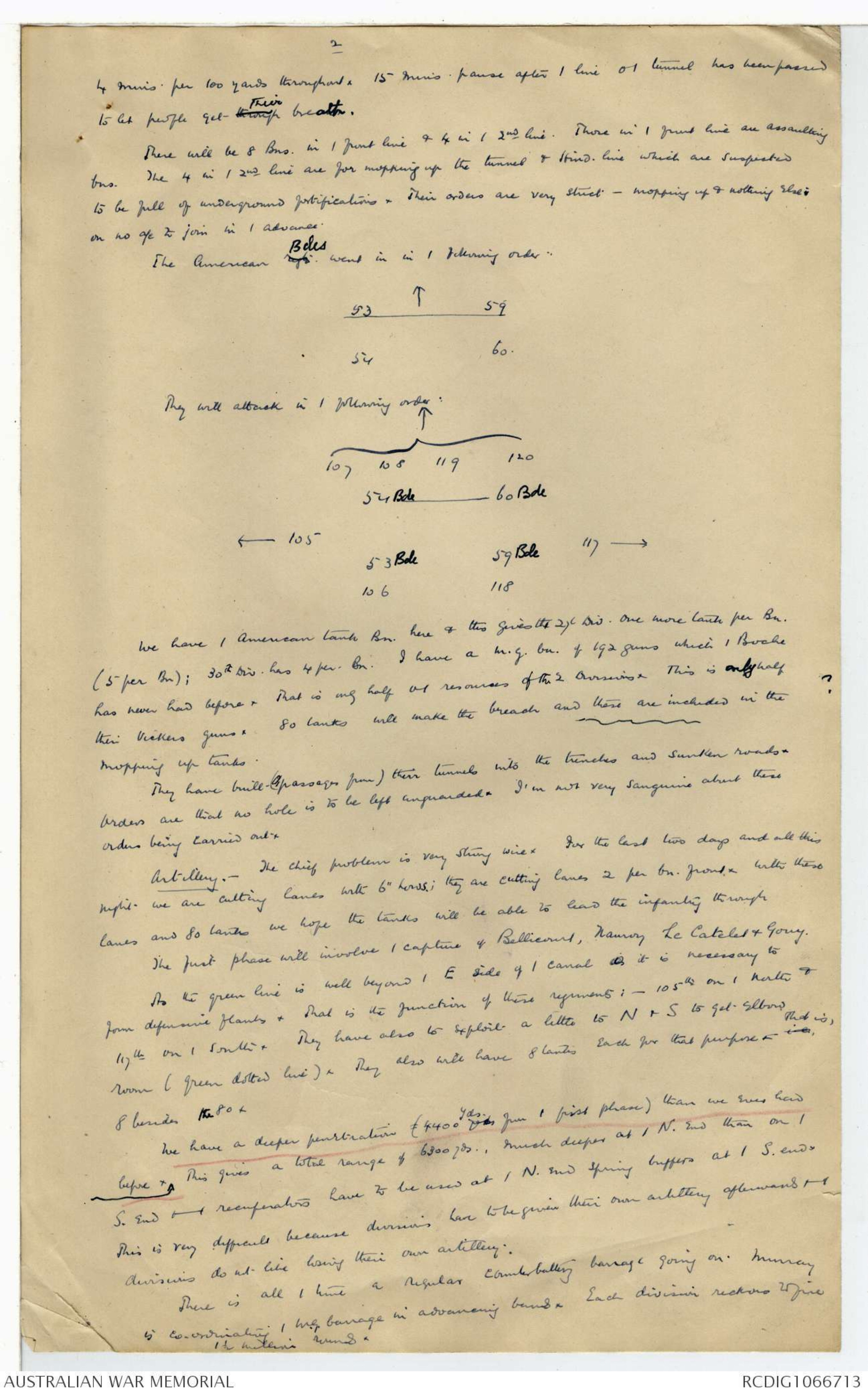

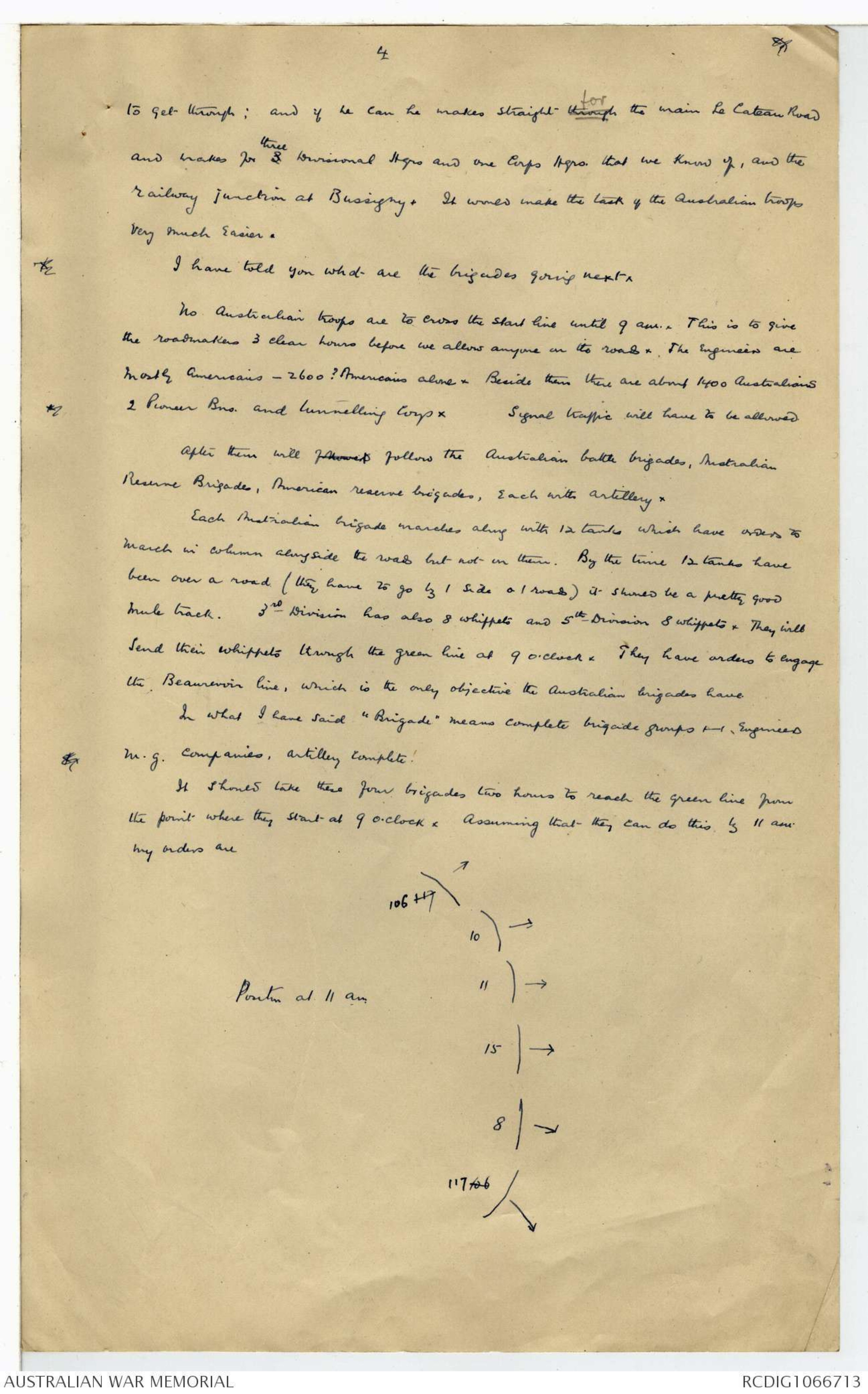
AWM38
Official History,
1914-18 War: Records of C E W Bean,
Official Historian.
Diaries and Notebooks
Item number: 3DRL606/274A/1
Title: Folder, 1918 - 1941
Covers the breaking of the Hindenburg Line and
includes notes, sketches, cuttings, material on
the "corpse factory" and letters by Maj Gen E
Tivey and others.
AWM-3DRL606/274A/1
HIST. NOTES - Sept-Oct. 1915 No 274(A)
1st SET
DIARIES AND NOTES OF C. E. W. BEAN
CONCERNING THE WAR OF 1914 - 1918
THE use of these diaries and notes is subject to conditions laid down in the terms
of gift to the Australian War Memorial. But, apart from those terms, I wish the
following circumstances and considerations to be brought to the notice of every
reader and writer who may use them.
These writings represent only what at the moment of making them I believed to be
true. The diaries were jotted down almost daily with the object of recording what
was then in the writer's mind. Often he wrote them when very tired and half asleep;
also, not infrequently, what he believed to be true was not so - but it does not
follow that he always discovered this, or remembered to correct the mistakes when
discovered. Indeed, he could not always remember that he had written them.
These records should, therefore, be used with great caution, as relating only what
their author, at the time of writing, believed. Further, he cannot, of course, vouch
for the accuracy of statements made to him by others and here recorded. But he
did try to ensure such accuracy by consulting, as far as possible, those who had
seen or otherwise taken part in the events. The constant falsity of second-hand
evidence (on which a large proportion of war stories are founded) was impressed
upon him by the second or third day of the Gallipoli campaign, notwithstanding that
those who passed on such stories usually themselves believed them to be true. All
second-hand evidence herein should be read with this in mind.
16 Sept., 1946. C. E. W. BEAN.
AWM38 3DRL 606 ITEM 274A [1]
OPEN
Hindenburg Line
29 Sept 1918
(Monashs plan - Conference
with Americans before action)
AMERICANS WERE
AMAZED
[*Sun. 8/10/31*]
GEN. MACKAY TELLS
Brigadier-General I.G. Mackay
recalls that the Americans were amazed
at the tremendous grip which Sir
John Monash had of the situation in
September, 1918, when he was planning
the attack on the Hindenburg line.
"My own most vivid recollection
of him," said General Mackay this
afternoon, "is at a conference of
Australian and American divisional
commanders just before that attack.
For upwards of two hours he addressed
the conference expounding
his plans for the breaking of the
German line and the subsequent push
through.
"He went into details of the action
he expected from the artillery,
cavalry, infantry, engineers, pioneers,
road-makers, tanks, air force and
every other participant. His whole
plan of campaign was most precise
and logical and was set out without
reference to a single note.
"General Lewis, commander of the
30th American Division and a graduate
of West Point, told me afterwards
that this address was the finest
thing he had ever listened to in
his life".
X File
29 Sept 1918
Hindbg Line
Anti Tank mines.
Jy 3 Aust Corps ms to 2 Aust D.
On 27 June a demonstn in use of 2" TM. Bomb as an
Anti-T. mine ws carrd out at Divn.
Ts were moved over grd sown w these mines (5' apart
in 3 lines) An ordy T. expld 3 fuses in trying to X
A Whippet explod one
An old tank dragged by anor ws put out of
actn by 1st mine struck.
Fuses were 107 pattern.
The Bombs are placed in grd flush w surface, only
fuse protruding, covered w rubber. Fuse then
covered w grass & rubbish.
Rept says: "I am of opinion tt a sectn o / front tt is mined
in this way shd have no fear of hostile Ts reaching
their front line."
2 Div asked its bdes if they wanted any
mines.
Jy 10. Answer for whole Corps:
None required as Ts can move anywhere on prest front.
Historical Notes.
From British Statistical Record.
Americans in France
Losses of
USA: k. 35,560
D of w 14,720
50,280 wd. 205,690
Prs. 41480.
Cas in USA & Europe 325,876
Aust. Losses:
k w Prisrs
Aust 59,330 152,171 4,084
From "Chronology of Wars"
Am. Decl war on 6 Ap 1917
1st Fighting tps in Fr. 25 June 1917 27 Oct in action 1st line.
"More tps" In F.L. 4 Feb 1918 (? was Toul sector then
taken over or merely extended?)
By July 2 over 1,000,000 embarked
13 Sept St Michel offensive launched
Reach Sedan 6 Nov.
July 18. Fr c/a. (2 American Divisions
with 11 or 12 French - check this)
From Book 236
A/c given ^on the evening of 27th by Gen. Monash to Murdoch Gilmour myself on Sept. 28th
Thee Canadians are on the outskirts of Cambrai.
The general line runs along / W side o / Canal. The 3rd Army got one Bn. across
first and has enabled xx a N.Z. Bde to cross, and they found 3 bridges at [Marcoing?]
not blown up. They have over 10000 prisoners. Haldane's Corps is working down that
spur and he is optimistic about reaching / extreme bend of / bend tonight. There is
still a big westward bend south of this. The 3rd Corps is still west of Villers Guislain.
Today the 2nd Army, a French Army & a Belgian Army attacked up north. Next
in order of sequence is the 4th Army. As far as I know the 1st French Army will follow
the day after.
My orders are to force the passage o / canal and breach the Hind. Line
between Bellicourt & Le Catelet, with a view to passing through / gap and establishing
what may be called a bridgehead on the Eastern side of it & at the same time
exploiting N. & S. from / gap made, with a view to uncovering / crossing o / canal
so that down south I may uncover passages for / IX Corps, & northward for / 3rd Corps
& / 3rd Army.
While on / N. / 3rd Army & / 3rd Corps will make no attempt independent of my attempt
to cross / canal, on the South / 9th Corps will try to cross independent of me at Bellenglise.
IX Corps are putting in / 46th Div & 6th Brit. Div. and will have the 1st and 32nd Divisions
up their sleeves. The 3rd Corps are holding a 2000 yds. front — they are quite played out.
The 5th Corps might cross at Vendhuille. I do not think / 3rd Corps will try to cross.
The 13th Corps with 4 Divisions is in reserve in the 4th Army and not employed at present.
To enable me to accomplish that task they have given me the 27th & 30th American
Divisions and a good deal of the artillery belonging to / 3rd Corps. I am placing /
27th in / north & / 30th Div in / south. Zero is 5.50 tomorrow morning.
Essential parts o / Plan: —
With Bad weather inexperienced troops I am not sure we can realise / whole
o / plan.
The trouble with the Americans is in their front line. The
The Americans do / first phase. 3rd & 5th Aust. Divisions exploit to / red line.
Total penetration to about 7000/8000 yards. Beyond that I have put down a
cavalry line because I have the 5th Brigade of Cavalry. The line runs west
of Brancourt. This is the least they must achieve — sure to go E of that
if they go at all. The black lines on / map are / eventual lines of advance -
American Corps, Australian Corps, IX Corps. The Americans have no artillery.
This far it is more a question of engineering and calculations than of fighting.
We have taken the first phase as though it were a set piece — attack under a barrage,
3500 yds to each division, barrage falling on dead-straight lines & we have (? for this)
17 field Artillery bdes & the barrage will come down 4 mins. in the start line &
Something missed.
?"In addition the 27th Divns
Division is 900 yards behind
its Jumping off Line, &
the guns 1000 yards
behind that."
(? or x protective barr)
2
4 mins per 100 yards throughout. 15 mins pause after / line o / tunnel has been passed
to let people get through their breath.
There will be 8 Bns. in / front line & 4 in / 2nd line. Those in / front line are assaulting
bns. The 4 in / 2nd line are for mopping up the tunnel & Hind. line which are suspected
to be full of underground fortifications. Their orders are very strict - mopping up & nothing else -
on no account to join in / advance.
The American right Bdes went in in / following order:
↑
53 59
54 60.
They will attack in / following order:
Diagram – see original document
We have / American tank Bn. here & this gives the 27th Div one more tank per Bn.
(5 per Bn); 30th Div has 4 per Bn. I have a M.G. bn. of 192 guns which / Boche
has never had before. That is mg half o / resources of the 2 [Armies?]. This is only half
their Vickers Guns. 80 tanks will make the breach and these are included in the
mopping up tanks.
They have built (8 passages from) their tunnels into the trenches and sunken roads.
Orders are that no hole is to be left unguarded. I'm not very sanguine about these
orders being carried out.
Artillery:- The chief problem is very strong wire. In the last two days and all this
night we are cutting lanes with 6" hows; they are cutting lanes 2 per bn. front. With these
lanes and 80 tanks we hope the tanks will be able to lead the infantry through
The first phase will involve / capture of Bellicourt, Nauroy Le Catelet & Gouy.
As the green line is well beyond / E side of / canal xx it is necessary to
form defensive flanks & that is the function of these regiments: — 105th on / North &
117th on / South. They have also to exploit a little to N & S to get elbow
room (green dotted line). They also will have 8 tanks each for this purpose. xx That is
8 besides the 80.
We have a deeper penetration (4400 xx yds from / first phase) than we ever had
before. ↑ This gives a total range of 6300 yds. Much deeper at / N. end than on /
S. end — recuperators have to be used at / N. end Spring buffers at / S. end.
This is very difficult because divisions have to be given their own artillery afterwards & / divisions do not like having their own artillery.
There is all / time a regular counterbattery barrage going on. Murray
is coordinating / m.g. barrage in advancing bands. Each division reckons to fire
1½ millions rounds.
3
Now comes the problem. Having carried infantry 4000 yds, that enormous distance,
how are we going to get them further? We have to get artillery forward. We cannot do
that without roads. We had photos taken very low of all / area. With / Chief Engr I have
picked out 4 roads. As far as we can go up to the tape line these roads are complete,xx and / bivouac lines where they spend tonight are ready.
Immediately after / assault tomorrow 4 doz strong groups of Engineers & pioneers
will follow / battle & spread themselves over / route. We will not bridge trenches but
fill trenches. Cut away wire & so on. If the trenches are no worse than I suppose
it will take 3 hours to complete this to / Le Catelet line, beyond which I assume
there is open country.
These 4 roads will be staked and marked tomorrow by notice boards in these
colours, so that if a bde is told it will have to march by / red xx road it will
see / red signboard.
The black and yellow roads will be the best & will be developed for mechanical
transport. The first effort will be to organise them for field artillery & infantry at a pinch
can go across country.
Tonight / four Austr. brigades with / reserve bdes. allotted to them have allocated
areas leading to their various routes.
Right (xxxx) (Cavalry)
Black - 8th Bde followed by 14th
Red 15th "
Yellow 11th "(Cavalry) Blue 10th " " " 9th
Left (Cavalry)
The reserve Bdes march on / outer route. The object is that as / battle
develops these bdes. will be on / outer sides of our salient.
Every one of these ^six brigades is accompanied by a bde of artillery. Instead of
these having to come out o / barrage they are tonight already camped with their infantry, -
horses, guns & all. They are not in the barrage. In addition to these six bdes.
each division has a mobile group of horse artillery - horse-drawn 60-pdrs and
horse drawn 6" Vickers naval guns. These will be used in counter-battery
work and can easily pull out.
3rd & 5th Divisions have to deploy on the green line and carry a moving
battle to / Red Line.
Zero 5.50. Green Line 9.30 about. First thing after the advance
Engineers go forward. Then the armoured car battn from Tincourt comes
by the Yellow road and pushes its way through it if it can to / Green line.
In order to help it, it is accompanied by 8 whippet tanks. I am not very
sanguine that the armoured cars can do anything like what they did before.
I have told the armoured car ^battn commander that I am not going to allow him
to run unnecessary risks. He is to go through xxx and seize any opportunity
4 8X
to get through; and if he can he makes straight through for the main Le Catelet Road
and makes for 3 three Divisional Hqrs and one Corps Hqrs that we know of, and the
railway junction at Bussigny. It would make the task of the Australian troops
very much easier.x I have told you what are the brigades going next.
No Australian troops are to cross the start line until 9 a.m. This is to give
the roadmakers 3 clear hours before we allow anyone on its roads. The Engineers are
mostly Americans - 2600 ? Americans alone. Beside them there are about 1400 Australiansx2 2 Pioneer Bns and tunnelling Coys. Signal traffic will have to be allowed
After them will followed follow the Australian battle brigades, Australian
Reserve Brigades, American reserve brigades, each with artillery.
Each Australian brigade marches along with 12 tanks which have orders to
march in column alongside the roads but not in them. By the time 12 tanks have
been over a road (they have to go by the side o / roads) it should be a pretty good
mule track. 3rd Division has also 3 Whippets and 5th Division 8 Whippets. They will
send their Whippets through the green line at 9 o'clock. They have orders to engage
the Beaurevoir line, which is the only objective the Australian brigades have
In what I have said "Brigade" means complete brigade groups, - Engineers89 m.g. companies, artillery complete.
It should take these four brigades two hours to reach the Green line from
the point where they start at 9 o'clock. Assuming that they can do this by 11 am
my orders are
Diagram – see original document
Positn at 11 a.m.
 Sam scott
Sam scottThis transcription item is now locked to you for editing. To release the lock either Save your changes or Cancel.
This lock will be automatically released after 60 minutes of inactivity.